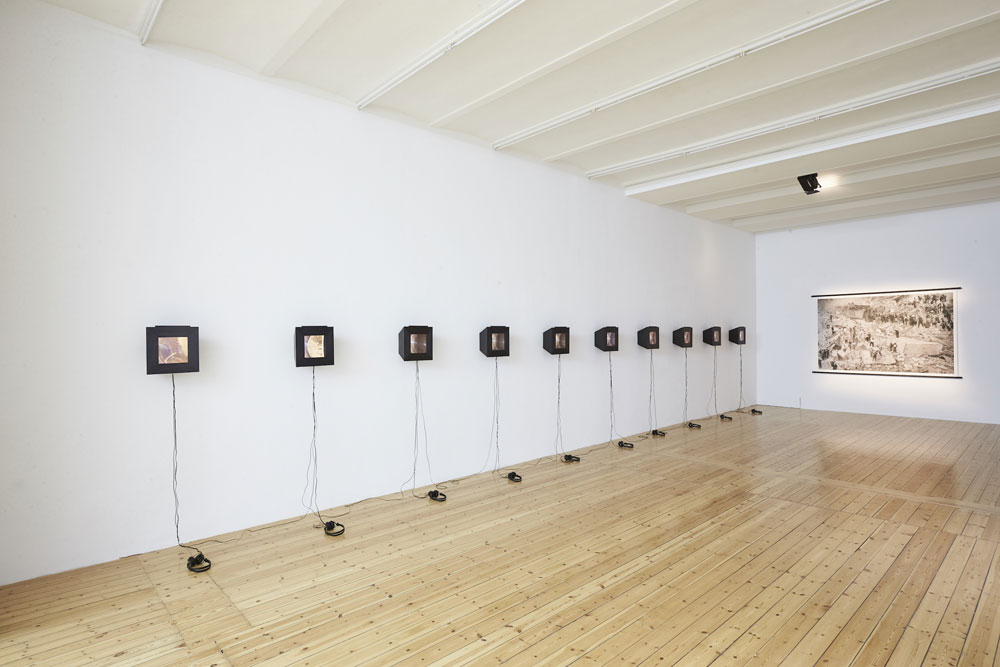Rabih Mroué
Sfeir-Semler Gallery, Hamburg, Germany
Sfeir-Semler Gallery, Hamburg, Germany

There’s a nightclub in Beirut called B 018 that is infamous for its vampiric existence. Built in the city’s Quarantina neighbourhood, its underground space has a metal ceiling that opens up to bathe revellers in starlight. With its coffin-like interior and gruesome history (the area is rumoured to be home to a mass grave), it is what Lebanese artist Rabih Mroué calls an in-between space – a place where the living and the dead might commune.
In Duo for Two Missing Persons (2013), the video that introduced Mroué’s solo show at Sfeir-Semler in Hamburg, he asks: could dance act as a conduit between life and death? The video traces the artist’s interest in mass graves and the grisly reality that, in such situations, bones must, by default, mix with each other, in a sort of macabre dance of disjointed bodies. To illustrate this, he mapped the number of possible combinations that two dismembered bodies could be reassembled into and sent it to a choreographer friend, asking him to use it as inspiration. The resulting choreography, which calls for painstakingly slow, continuous movement, manifests the stillness of death meeting the animation of life. Duo, like much of Mroué’s work, draws on the artist’s background in theatre and performance, while illustrating the forensic-like method of investigation he shares with postwar Lebanese artists such as Walid Raad and Akram Zaatari.

Starting with the dance notation of Duo, the exhibition was pervaded by a sense that, even when the human body was absent, the suggestion of a person remained present. The Crocodile who Ate the Sun (1982/2015) recalls the summer of 1982, when a 15-year-old Mroué witnessed Israel drop hundreds of thousands of threatening leaflets over Beirut. Thirty years later, the artist created facsimiles of the leaflets, gave them to his friends to hold and examine, and then photographed the papers after they’d been handled. Torn, taped, crumpled or even folded into a paper airplane, the photographed papers become mementos of trauma and physical manifestations of memories.
While the show featured two impressive wall-sized installations – Leap Year’s Diary (2006–16) and After Midnight (2013) – neither had the impact of the comparatively modest Black Box I-X (2006–16), comprising ten small boxes, each housing a small collage. In order to view the images, viewers had to crane their necks to gaze into the box. Attached to each unit were headphones that played radio clips, songs and newsreels, creating cinematic montages: an image of religious clerics looking down a gaping pit held up by oil drums was accompanied by a raw rendition of Nina Simone’s ‘Strange Fruit’ (1965); harrowing sounds from the 2004 Asian Tsunami played alongside a media clip boasting of the capabilities of the latest Israeli tank and an old Pathé newscast of the Hindenburg disaster: ‘An inferno that became a flaming tomb, a twisted mass of girding.’ But, ‘a tragedy will not halt the march of progress.’ Black Box I-X is relentless in its parade of human conflicts; man, Mroué seems to say, is destined to repeat the same travesties. And the artist does not let us escape that reality. By watching and listening, we are also implicated. Bending down and peering inside each box, it is not so easy to walk away: we cannot un-see what we have witnessed.

The remaining works in the show served to balance out the intensity of Black Box I-X. Between Two Battles (2013) engagingly illustrates Mroué’s aunt’s paranoid obsession with television white noise, and her conviction that it contains subliminal messages from the enemy. Two Hours without War (2013), meanwhile, stretches out the final two seconds of the last match of the 1982 World Cup between Italy and West Germany (which was cause for a ceasefire during the Israeli Siege of Beirut) to two minutes in length. The soundtrack of the film, the cheerful strains of Johann Sebastian Bach’s French Suite No. 6 (1722–25), spread through the entire gallery, adding a glorious yet absurd counterpoint to the disasters portrayed in Black Box.
In Duo, Mroué notes how the notation for a Baroque dance looks like a massacre: ‘For centuries are only a part of yesterday,’ he says, ‘and yesterday seems to be a long, a very long and exhausting day while the night was full of nightmares that are still haunting us today.’ This exhibition, then, was Mroué’s very own danse macabre: blending life and death, terror and the sublime. His understanding of what it is to be human, in all of its beauty and ugliness, burns through with an intensity that, despite – or because of – its theatricality, hits the viewer directly in the gut.
























